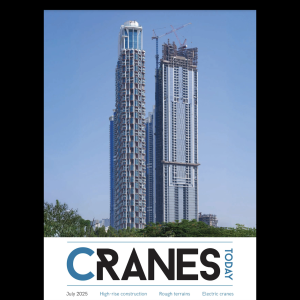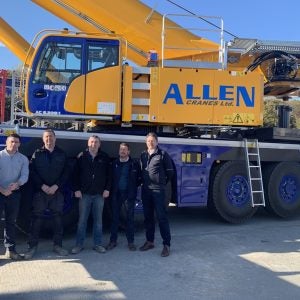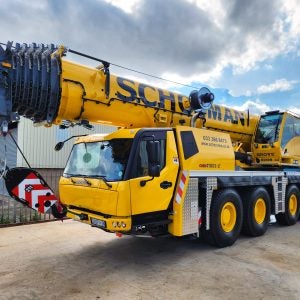Manitowoc pushed the message that an international strategy, taking in a range of end user applications, will protect it from the local effects of the US lending crisis on residentia andl commercial construction.
While some analysts raised a nervous climate among lenders as a threat to the firm’s ability to channel credit to crane buyers, Manitowoc believed the low depreciation rate of cranes, and the health of crane user businesses, would ensure that third party credit remained available.
The booming market could be seen by some as a chance to push price rises faster than the rise in cost of components, but Tellock said the importance of long-term relationships in a globally competitive market meant that price rises would be limited.
Broad end user markets
Giving an overview of Manitowoc’s activities, in cranes, marine and foodservice, to investors at a Lehman Brothers conference, Tellock said that US markets only account for 44% of its crane business. The company is further insulated from potential turmoil in US residential and commercial construction by the range of end user sectors its cranes serve.
Admitting that “we know pretty much where the first crane is going when we ship them, but the second, third, fourth time they go out, we are not as confident in that,” Tellock said, “Over 70% of our business goes to rental fleets, and we have conversations with them on a very, very ongoing basis and try to get a feel for where those second, third, and fourth cranes are going, or where their business is at today.”
Rather than residential or commercial construction, Tellock said these figures showed that, “when you add up the power plant, the industrial, petrochem and utilities, over 45% of our business is in energy-related markets… In the US, self-erecting towers and boom trucks are really only about 1% of our business that is supplied to the residential construction [and] 6% of our business is tied to the US commercial construction.”
Worldwide focus
Tellock repeated a message Manitowoc has been making consistently over recent months, that its investment focus is on building its international sales and production capacity: “As we continue to grow and we continue to bring the crane group closer together, we are trying to get a better feel for where some of these worldwide end markets are.”
Tellock said that one of the sources Manitowoc uses to predict worldwide trends is Global Insight, the same analyst firm that produces Cranes Today’s regular regional construction analysis. The analysts, Tellock said, are predicting 10% construction growth during 2011–2016, on worldwide markets. While analysts may not be ‘particularly robust’ about US growth, these worldwide forecasts are much stronger. Over the next year, Tellock said, Manitowoc is “looking for another very robust year in cranes with the top line growth over 20%.”
Describing the manufacturers’ investments in production plant over the last year, Tellock said, “We are putting the investments in to take advantage of the opportunities and where we see the global forecast going.” The group isn’t just building new capacity, but focussing on flow manufacturing, and the availability of production equipment in its plants around the world.
Availability of credit
An audience member asked how Manitowoc’s credit arm, CraneCREDIT, would be effected by the US credit crunch: “How would you characterise the appetite of your bank partners to extend credit to some of your clients, some of your customers? [Is there] any residual risk on your own balance sheet for the financing aspects of the business?”
CFO Carl Laurino explained, “With what has been going on in that debt market, this is something that we have been watching pretty closely. Manitowoc equipment has very strong residual value: from that perspective, and from our own customers’ health and how they get their financing, [financing issues] have not been a constraint that we have been seeing. From just the relationships that we have developed that fall under that umbrella of CraneCREDIT, that has been a very active program that has only moved in one direction pretty consistently since we established it a few years ago.”
On the issue of risk related to Manitowoc’s crane sales financing, Laurino pointed out that the company’s reports disclose these figures, and that the overall risk comes in at around $170m: “And obviously relative to the segment, that is not significant… From a true risk standpoint, it’s pretty de minimis.” Laurino noted that this risk did not include repossessions in the event of a customer failing to meet financing agreements, making it a conservative estimate.
Competition from China
Responding to another audience member, Tellock went on to explain how the crane sectors products competed with local manufacturers in China: “Our prices can be anywhere from 40% to 50% higher than the Chinese product. The way [the Chinese] interpret fair trade, there is about a 17% duty on anything that is lower than 300 tons to sell it into China. So we are at a huge disadvantage. So really on the crawler cranes, our 999 model and lower, we have quit selling into China.
“But on everything else you can get duty exemptions and a lot of the customers are in fact buying our products. The Chinese [manufacturers] don’t have some of the larger products. They don’t have some of the self-erecting capabilities. They don’t have the support, whether it be for an all-terrain crane or whether it be a crawler crane. In tower cranes, we are very competitive on pricing for the cranes we sell into China because we have a Chinese manufacturer.
“So we decide of what is produced in China, we have tried to locally source as much of it [as we can]. We watch that as a metric on each model: how much is locally sourced. But at the same time, because of demand elsewhere in the world, we’re selling a lot of that product outside of China. So we pick and choose what we want to do in China and take advantage of some of the emerging markets outside of China with those Asian-made cranes.”
Restrictions on price rises
The final question for the Manitowoc team asked about the crane sector’s predicted revenue growth, and ‘how much of that is price?’ Tellock responded, saying, “Mid-single digit, maybe.”
The audience member asked, “From a pricing perspective, is the idea to just offset new cost increases or given the tight capacity do you have the ability to push price more than margins?”
Tellock explained, “You certainly want to get ahead of the curve, but at the same time, you have to be careful. This is a very relationship-driven business and… you have got to be careful not to gouge. My attitude there is the pigs get fed and hogs get slaughtered because of the Chinese competition. You have got to remember the volumes we have in the whole lifting side of the business are not very big. And when you get to some of these, when the markets do turn or they slow down, it’s a volume driven thing and they will have alternatives. And I would rather not take that chance.”






